Jackson M.J. Micro and Nanomanufacturing
Подождите немного. Документ загружается.

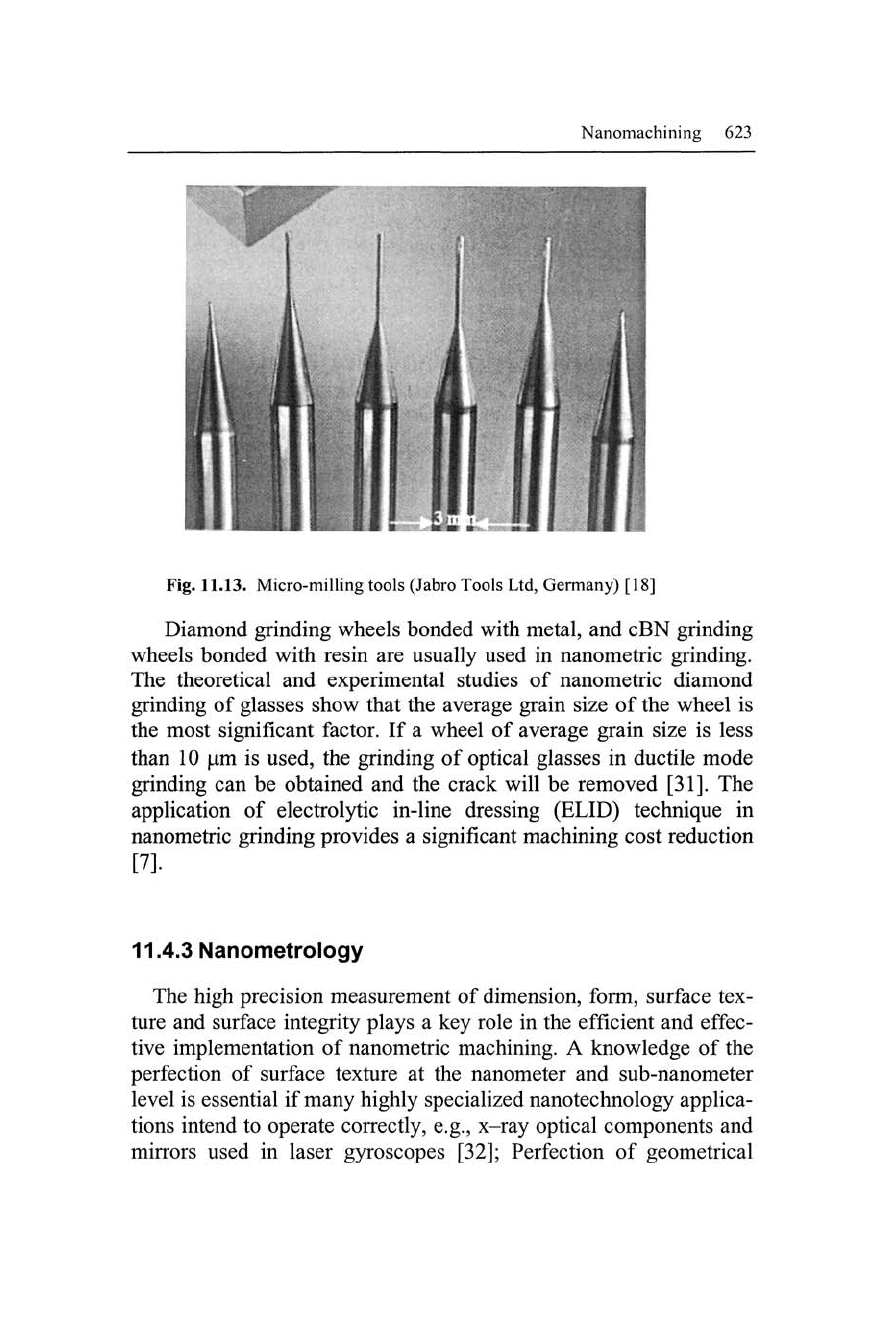
Nanomachining 623
Fig. 11.13. Micro-milling tools (Jabro Tools Ltd, Germany) [18]
Diamond grinding wheels bonded with metal, and cBN grinding
wheels bonded with resin are usually used in nanometric grinding.
The theoretical and experimental studies of nanometric diamond
grinding of glasses show that the average grain size of the wheel is
the most significant factor. If a wheel of average grain size is less
than 10 iLim is used, the grinding of optical glasses in ductile mode
grinding can be obtained and the crack will be removed [31]. The
application of electrolytic in-line dressing (ELID) technique in
nanometric grinding provides a significant machining cost reduction
[7].
11.4.3 Nanometrology
The high precision measurement of dimension, form, surface tex-
ture and surface integrity plays a key role in the efficient and effec-
tive implementation of nanometric machining. A knowledge of the
perfection of surface texture at the nanometer and sub-nanometer
level is essential if many highly specialized nanotechnology applica-
tions intend to operate correctly, e.g., x-ray optical components and
mirrors used in laser gyroscopes [32]; Perfection of geometrical
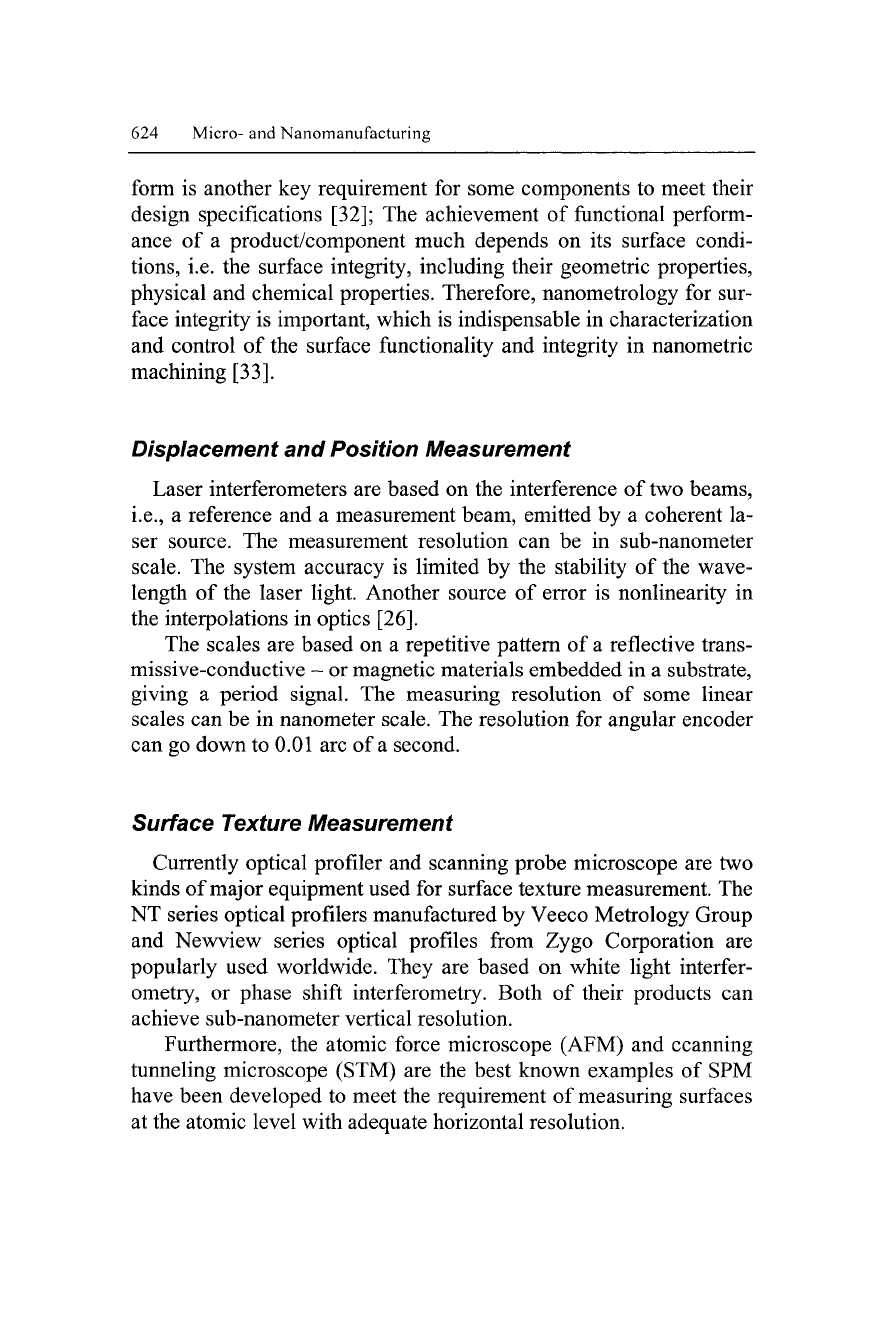
624 Micro- and Nanomanufacturing
form is another key requirement for some components to meet their
design specifications [32]; The achievement of functional perform-
ance of a product/component much depends on its surface condi-
tions,
i.e. the surface integrity, including their geometric properties,
physical and chemical properties. Therefore, nanometrology for sur-
face integrity is important, which is indispensable in characterization
and control of the surface functionality and integrity in nanometric
machining [33].
Displacement
and
Position Measurement
Laser interferometers are based on the interference of two beams,
i.e., a reference and a measurement beam, emitted by a coherent la-
ser source. The measurement resolution can be in sub-nanometer
scale. The system accuracy is limited by the stability of the wave-
length of the laser light. Another source of error is nonlinearity in
the interpolations in optics [26].
The scales are based on a repetitive pattern of a reflective trans-
missive-conductive - or magnetic materials embedded in a substrate,
giving a period signal. The measuring resolution of some linear
scales can be in nanometer scale. The resolution for angular encoder
can go down to 0.01 arc of a second.
Surface Texture Measurement
Currently optical profiler and scanning probe microscope are two
kinds of major equipment used for surface texture measurement. The
NT series optical profilers manufactured by Veeco Metrology Group
and Newview series optical profiles from Zygo Corporation are
popularly used worldwide. They are based on white light interfer-
ometry, or phase shift interferometry. Both of their products can
achieve sub-nanometer vertical resolution.
Furthermore, the atomic force microscope (AFM) and ccanning
tunneling microscope (STM) are the best known examples of SPM
have been developed to meet the requirement of measuring surfaces
at the atomic level with adequate horizontal resolution.
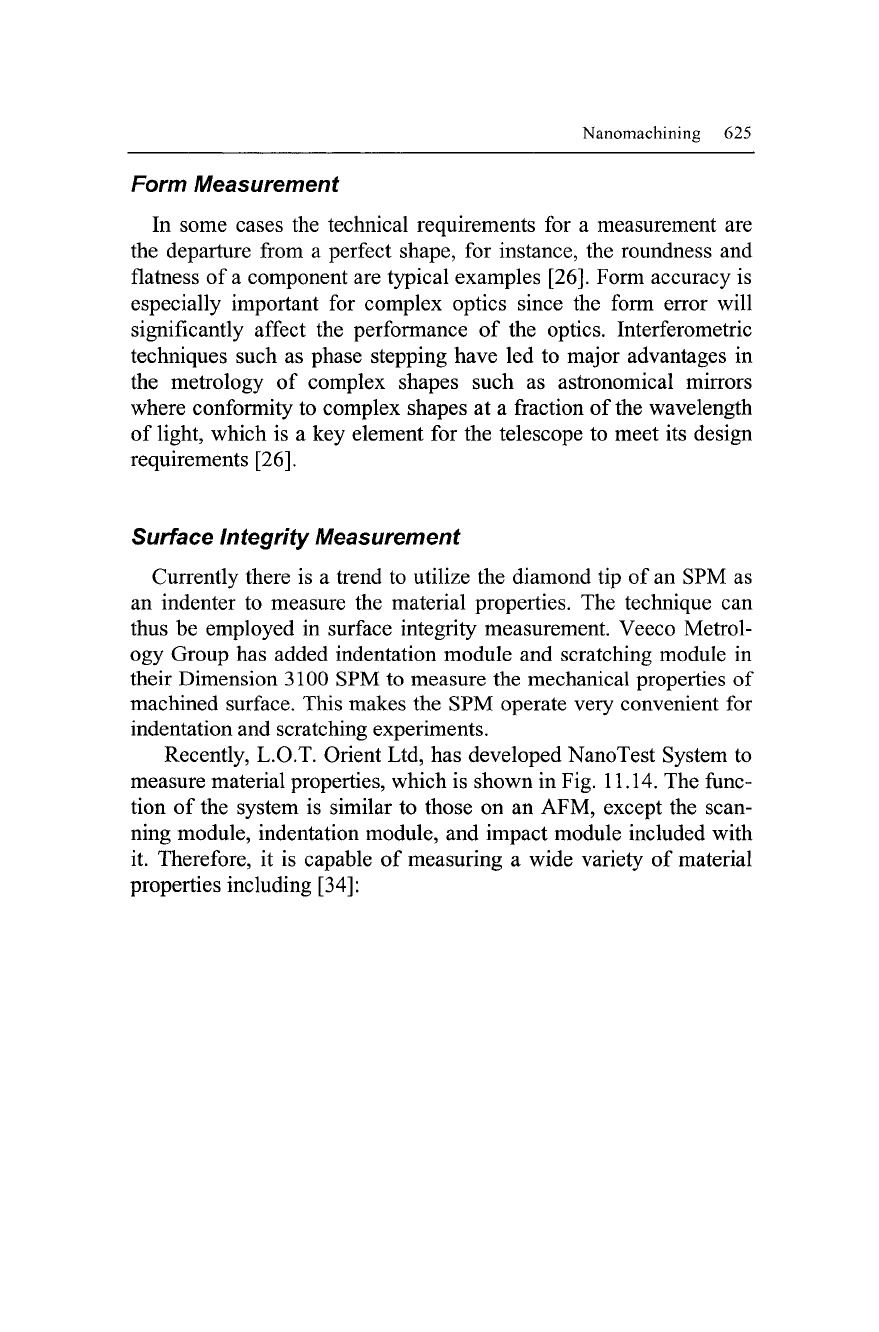
Nanomachining 625
Form Measurement
In some cases the technical requirements for a measurement are
the departure from a perfect shape, for instance, the roundness and
flatness of a component are typical examples [26]. Form accuracy is
especially important for complex optics since the form error will
significantly affect the performance of the optics. Interferometric
techniques such as phase stepping have led to major advantages in
the metrology of complex shapes such as astronomical mirrors
where conformity to complex shapes at a fraction of the wavelength
of light, which is a key element for the telescope to meet its design
requirements [26].
Surface Integrity Measurement
Currently there is a trend to utilize the diamond tip of an SPM as
an indenter to measure the material properties. The technique can
thus be employed in surface integrity measurement. Veeco Metrol-
ogy Group has added indentation module and scratching module in
their Dimension 3100 SPM to measure the mechanical properties of
machined surface. This makes the SPM operate very convenient for
indentation and scratching experiments.
Recently, L.O.T. Orient Ltd, has developed NanoTest System to
measure material properties, which is shown in Fig. 11.14. The func-
tion of the system is similar to those on an AFM, except the scan-
ning module, indentation module, and impact module included with
it. Therefore, it is capable of measuring a wide variety of material
properties including [34]:
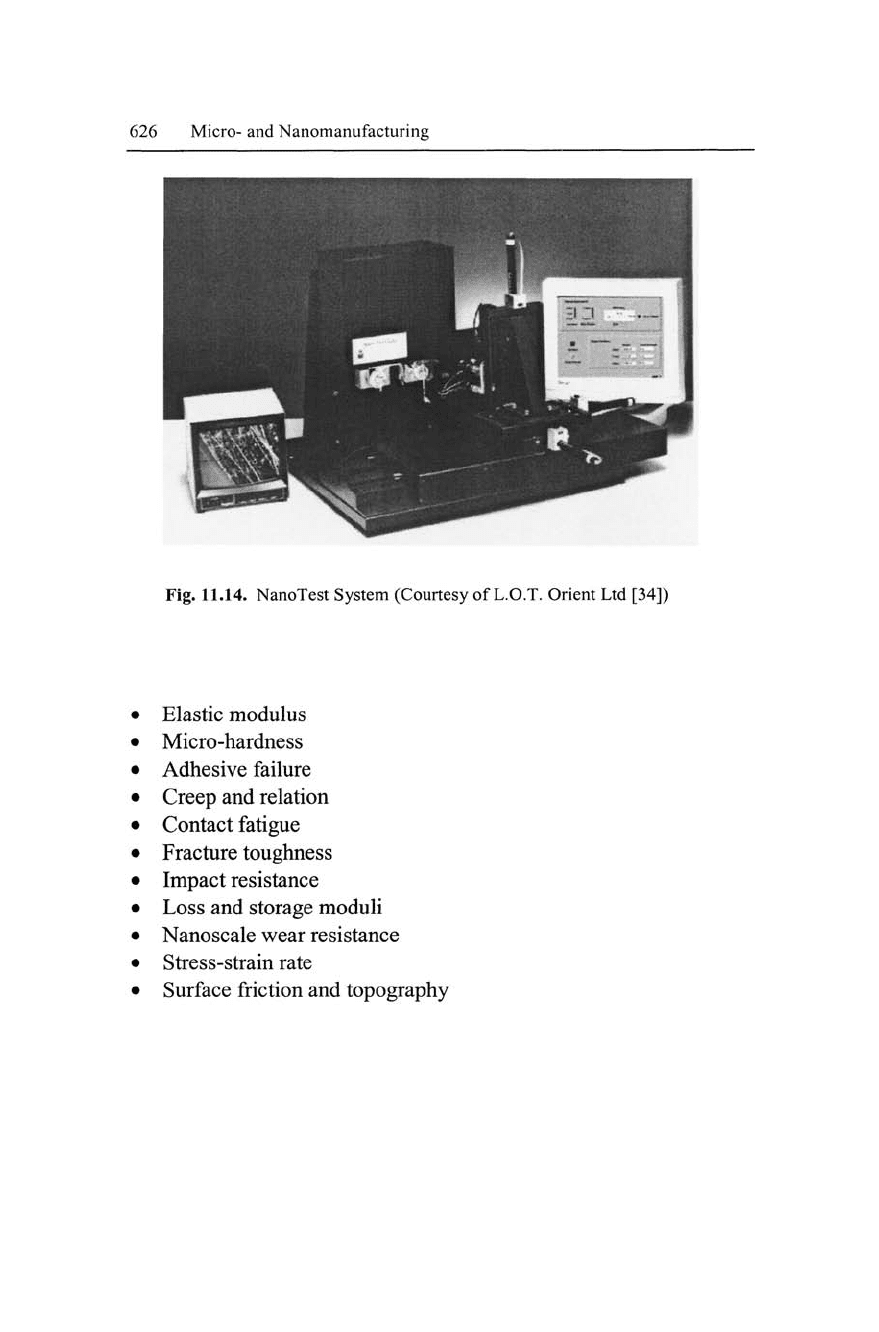
626 Micro- and Nanomanufacturing
Fig. 11.14. NanoTest System (Courtesy of L.O.T. Orient Ltd [34])
Elastic modulus
Micro-hardness
Adhesive failure
Creep and relation
Contact fatigue
Fracture toughness
Impact resistance
Loss and storage moduli
Nanoscale wear resistance
Stress-strain rate
Surface friction and topography
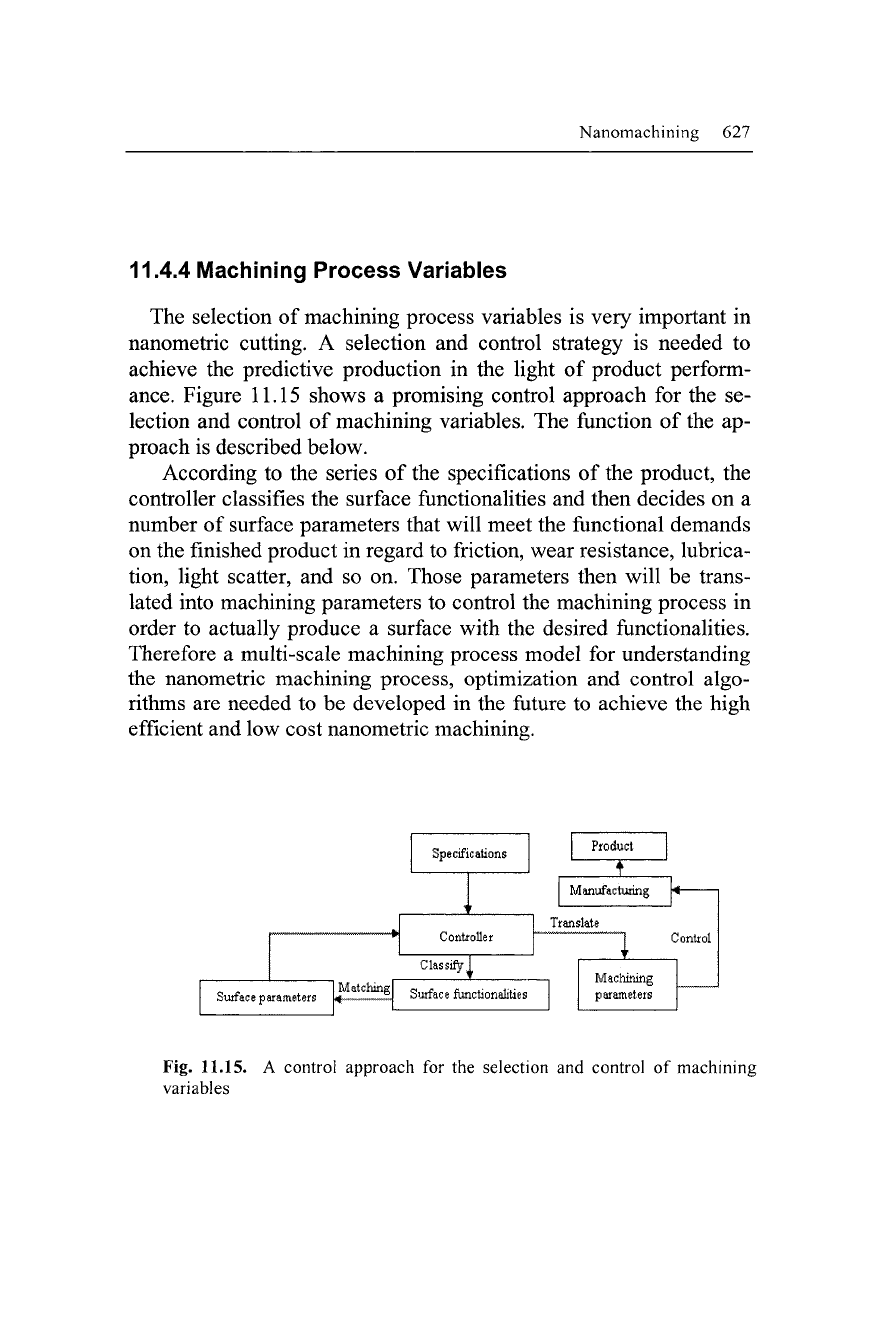
Nanomachining 627
11.4.4 Machining Process Variables
The selection of machining process variables is very important in
nanometric cutting. A selection and control strategy is needed to
achieve the predictive production in the light of product perform-
ance.
Figure 11.15 shows a promising control approach for the se-
lection and control of machining variables. The function of the ap-
proach is described below.
According to the series of the specifications of the product, the
controller classifies the surface functionalities and then decides on a
number of surface parameters that will meet the functional demands
on the finished product in regard to friction, wear resistance, lubrica-
tion, light scatter, and so on. Those parameters then will be trans-
lated into machining parameters to control the machining process in
order to actually produce a surface with the desired functionalities.
Therefore a multi-scale machining process model for understanding
the nanometric machining process, optimization and control algo-
rithms are needed to be developed in the future to achieve the high
efficient and low cost nanometric machining.
specifications
Controllei:
Classify
Surface parameters
[|^!—?
Siarface f\mctionalities
Product
X
Manufacturing
Translate
Machining
parameters
Control
Fig. 11.15. A control approach for the selection and control of machining
variables
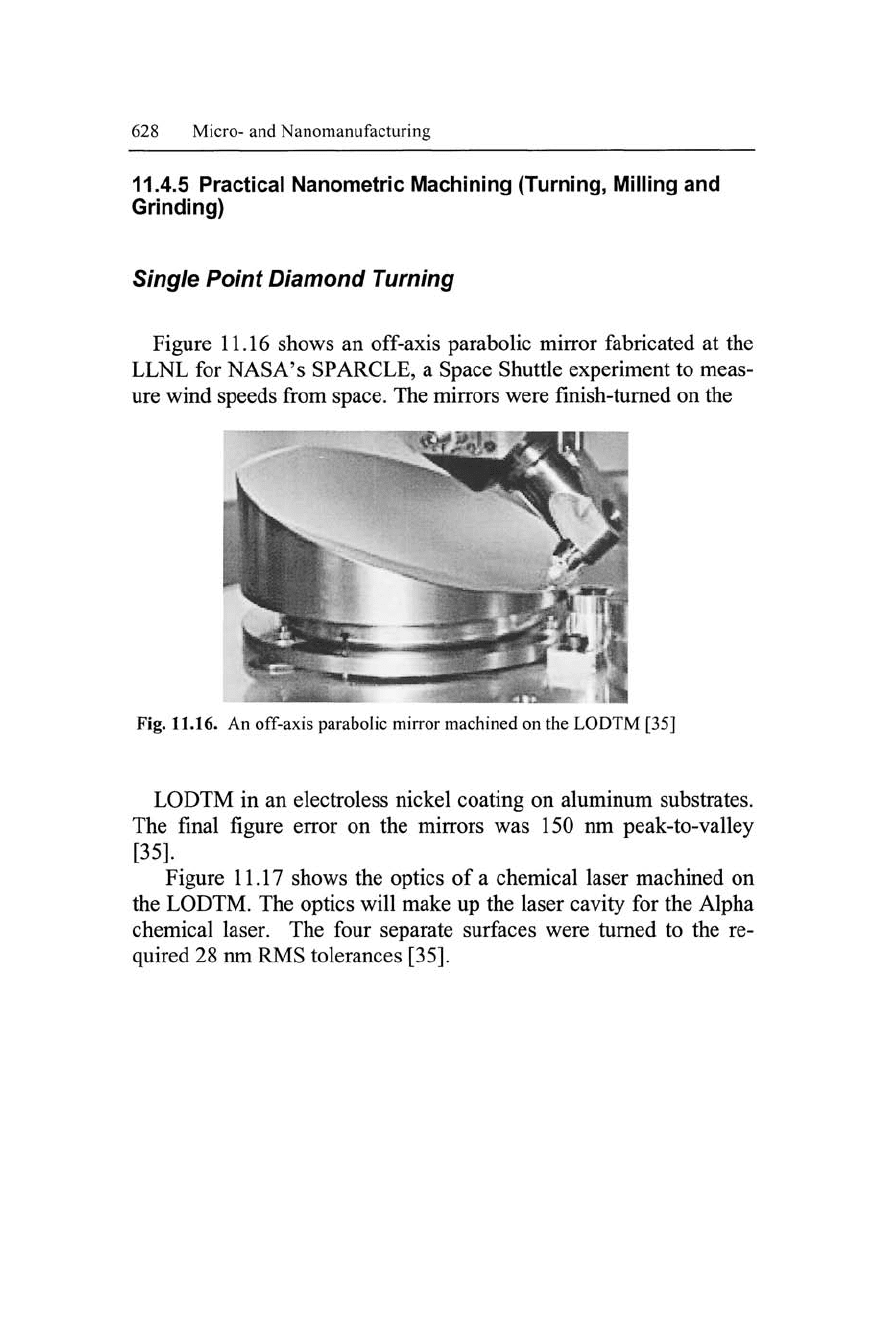
628 Micro- and Nanomanufacturing
11.4.5 Practical Nanometric Machining (Turning, IVIilling and
Grinding)
Single Point Diamond Turning
Figure 11.16 shows an off-axis parabolic mirror fabricated at the
LLNL for NASA's SPARCLE, a Space Shuttle experiment to meas-
ure wind speeds from space. The mirrors were finish-turned on the
Fig. 11.16. An off-axis parabolic mirror machined on the LODTM [35]
LODTM in an electroless nickel coating on aluminum substrates.
The final figure error on the mirrors was 150 nm peak-to-valley
[35].
Figure 11.17 shows the optics of a chemical laser machined on
the LODTM. The optics will make up the laser cavity for the Alpha
chemical laser. The four separate surfaces were turned to the re-
quired 28 nm RMS tolerances [35].
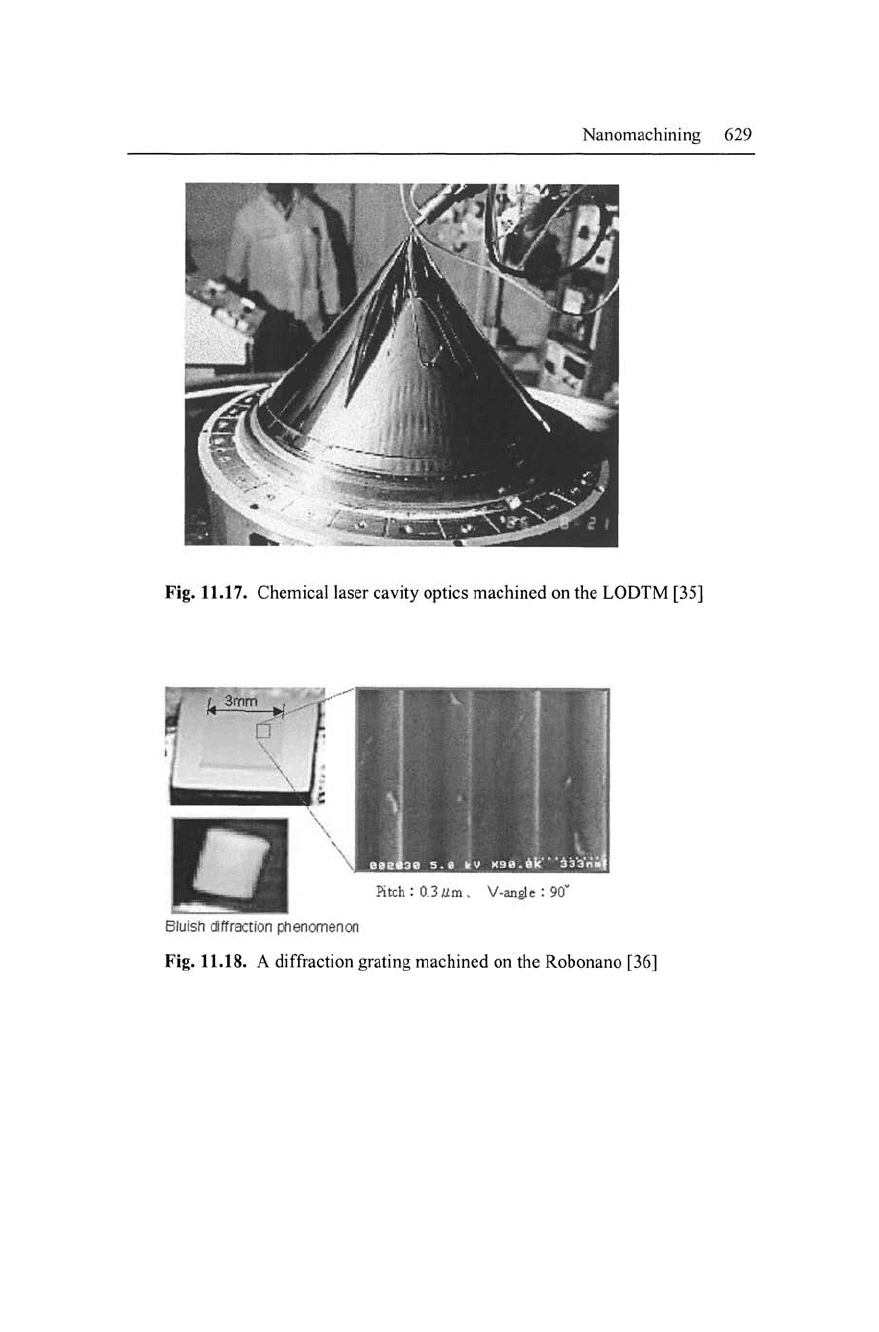
Nanomachining 629
Fig. 11.17. Chemical laser cavity optics machined on the LODTM [35]
Pitch: 0.3Wm. V-anglc : 90"
Bluish diffraction phenomenon
Fig. 11.18. A diffraction grating machined on the Robonano [36]
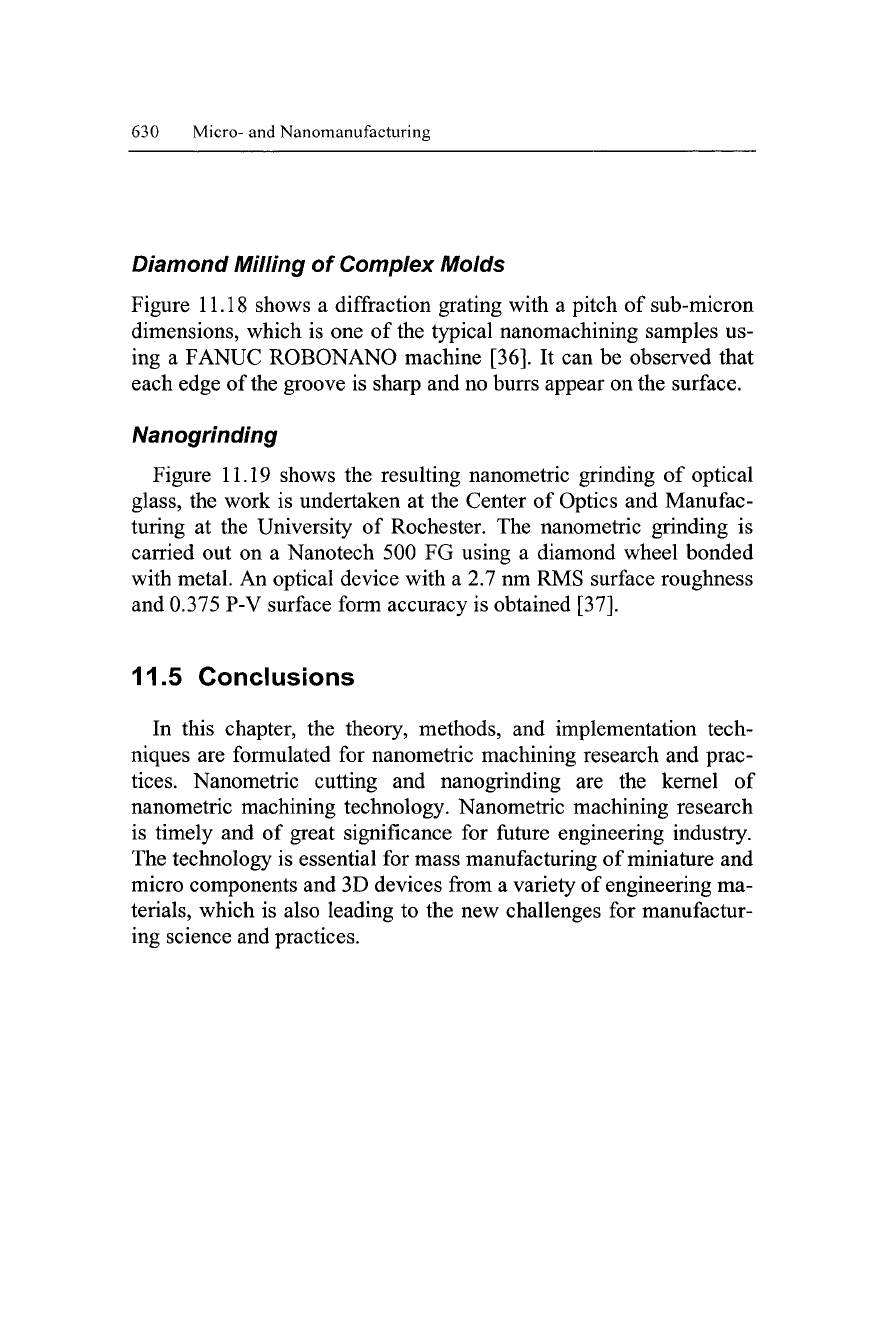
630 Micro- and Nanomanufacturing
Diamond Milling
of
Complex Molds
Figure 11.18 shows a diffraction grating with a pitch of sub-micron
dimensions, which is one of the typical nanomachining samples us-
ing a FANUC ROBONANO machine [36]. It can be observed that
each edge of the groove is sharp and no burrs appear on the surface.
Nanogrinding
Figure 11.19 shows the resulting nanometric grinding of optical
glass,
the work is undertaken at the Center of Optics and Manufac-
turing at the University of Rochester. The nanometric grinding is
carried out on a Nanotech 500 FG using a diamond wheel bonded
with metal. An optical device with a 2.7 nm RMS surface roughness
and 0.375 P-V surface form accuracy is obtained [37].
11.5 Conclusions
In this chapter, the theory, methods, and implementation tech-
niques are formulated for nanometric machining research and prac-
tices.
Nanometric cutting and nanogrinding are the kernel of
nanometric machining technology. Nanometric machining research
is timely and of great significance for future engineering industry.
The technology is essential for mass manufacturing of miniature and
micro components and 3D devices from a variety of engineering ma-
terials, which is also leading to the new challenges for manufactur-
ing science and practices.
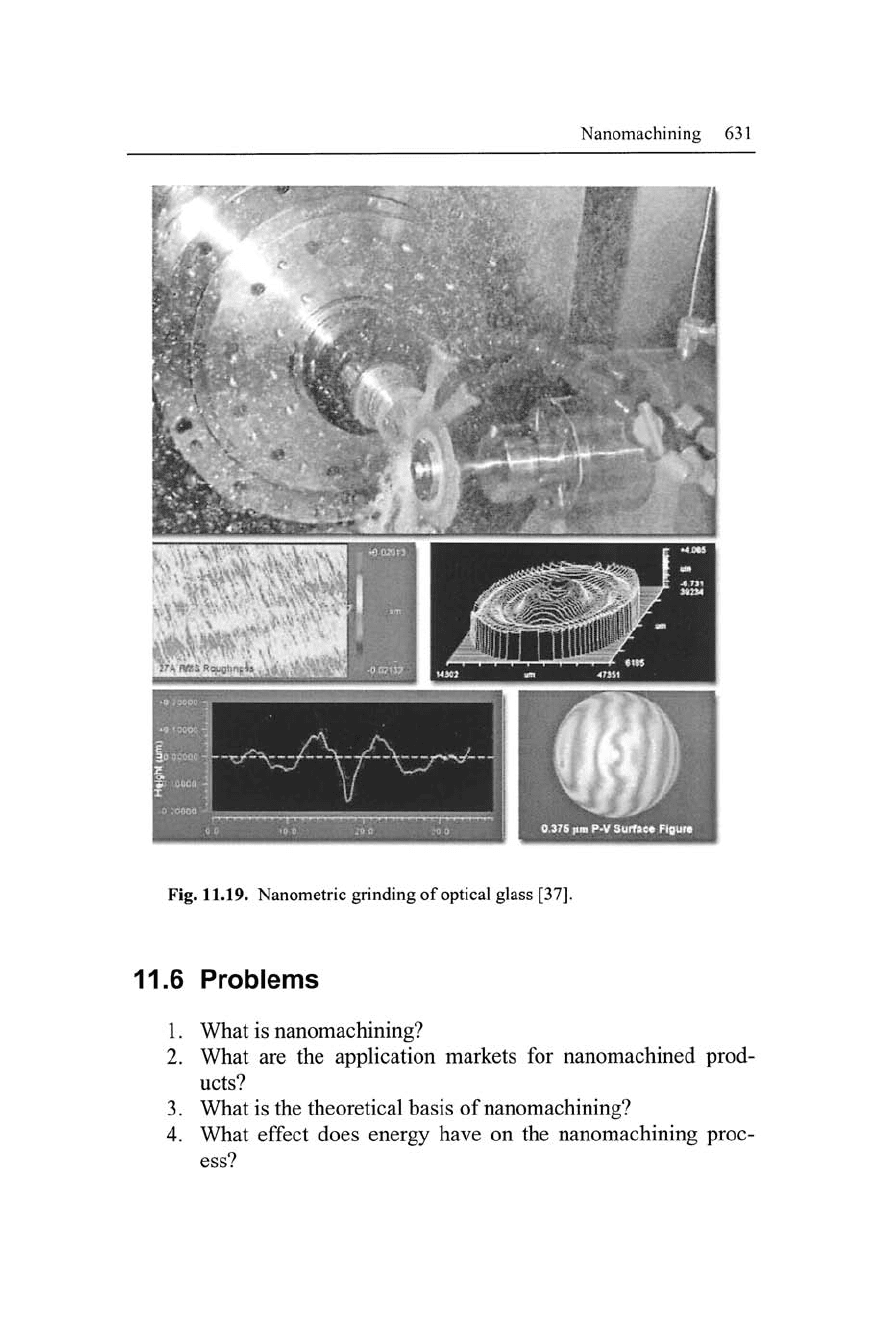
Nanomachining 631
Fig. 11.19. Nanometric grinding of optical glass [37].
11.6 Problems
1.
What is nanomachining?
2.
What are the apphcation markets for nanomachined prod-
ucts?
3.
What is the theoretical basis of nanomachining?
4.
What effect does energy have on the nanomachining proc-
ess?
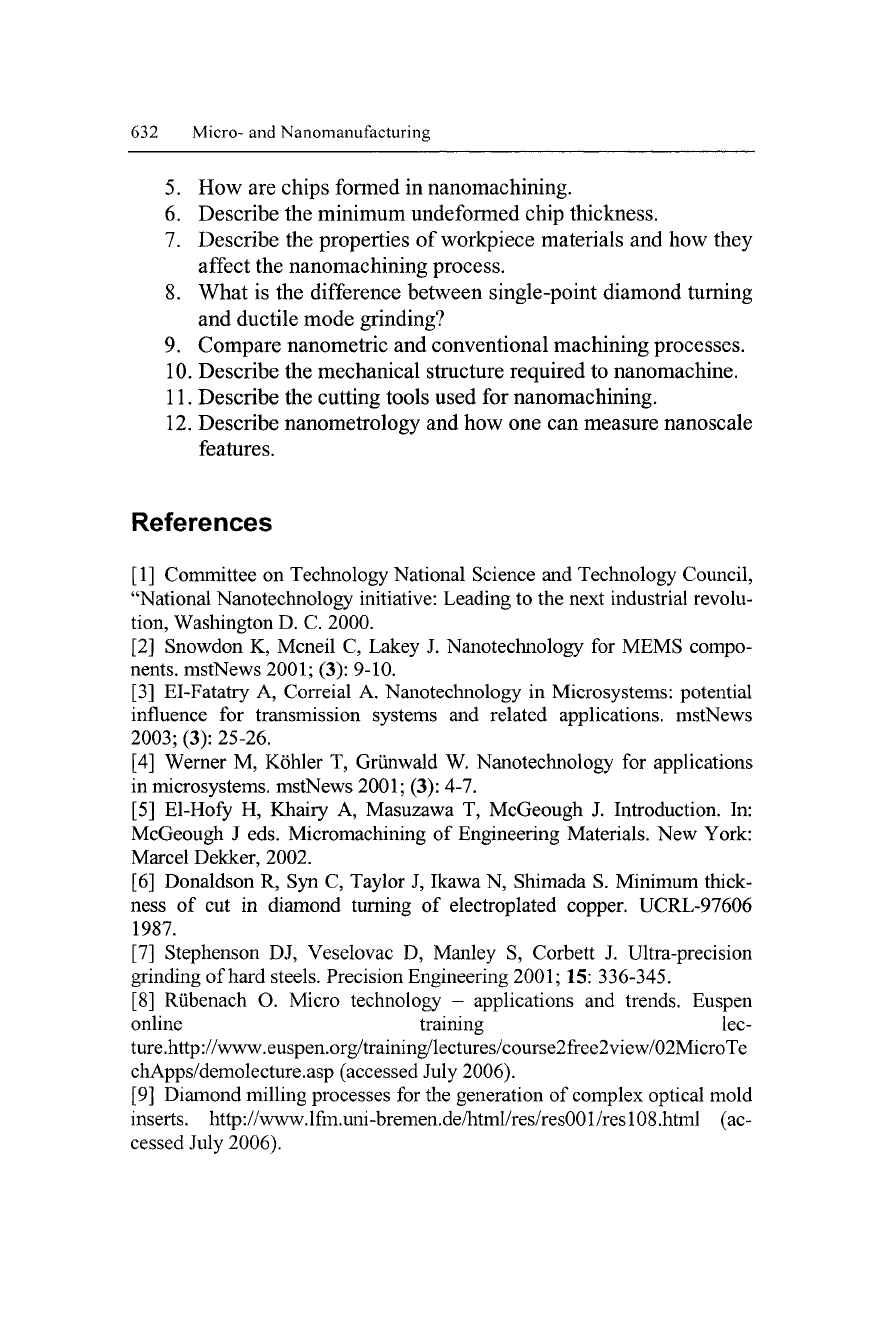
632 Micro- and Nanomanufacturing
5.
How are chips formed in nanomachining.
6. Describe the minimum undeformed chip thickness.
7.
Describe the properties of workpiece materials and how they
affect the nanomachining process.
8. What is the difference between single-point diamond turning
and ductile mode grinding?
9. Compare nanometric and conventional machining processes.
10.
Describe the mechanical structure required to nanomachine.
11.
Describe the cutting tools used for nanomachining.
12.
Describe nanometrology and how one can measure nanoscale
features.
References
[1] Committee on Technology National Science and Technology Council,
"National Nanotechnology initiative: Leading to the next industrial revolu-
tion, Washington
D.
C. 2000.
[2] Snowdon K, Mcneil C, Lakey J. Nanotechnology for MEMS compo-
nents.
mstNews
2001;
(3): 9-10.
[3] EI-Fatatry A, Correial A. Nanotechnology in Microsystems: potential
influence for transmission systems and related applications. mstNews
2003;
(3): 25-26.
[4] Werner M, Kohler T, Griinwald W. Nanotechnology for applications
in microsystems. mstNews
2001;
(3): 4-7.
[5] El-Hofy H, Khairy A, Masuzawa T, McGeough J. Introduction. In:
McGeough J eds. Micromachining of Engineering Materials. New York:
Marcel Dekker, 2002.
[6] Donaldson R, Syn C, Taylor J, Ikawa N, Shimada S. Minimum thick-
ness of cut in diamond tuming of electroplated copper. UCRL-97606
1987.
[7] Stephenson DJ, Veselovac D, Manley S, Corbett J. Ultra-precision
grinding of hard steels. Precision Engineering
2001;
15: 336-345.
[8] Rubenach O. Micro technology - applications and trends. Euspen
online training lec-
ture.http://www.euspen.org/training/lectures/course2free2view/02MicroTe
chApps/demolecture.asp (accessed July 2006).
[9] Diamond milling processes for the generation of complex optical mold
inserts, http://www.lfm.uni-bremen.de/html/res/res001/resl08.html (ac-
cessed July 2006).
